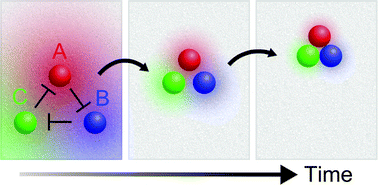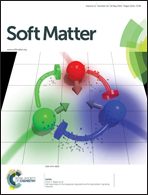Self-assembly of microcapsules regulated via the repressilator signaling network†
Abstract
One of the intriguing challenges in designing active matter is devising systems that not only self-organize, but also exhibit self-regulation. Inspired by biological regulatory networks, we design a collection of self-organizing, self-regulating microcapsules that move in response to self-generated chemical signals. Three microcapsules act as localized sources of distinct chemicals that diffuse through surrounding fluid. Production rates are modulated by the “repressilator” regulatory network motif: each chemical species represses the production of the next in a cycle. Depending on the maximum production rates and capsule separation distances, we show that immobile capsules either exhibit steady or oscillatory chemical production. We then consider movement of the microcapsules over the substrate, induced by gradients in surface energy due to adsorbed chemicals. We numerically simulate this advection–diffusion–reaction system with solid–fluid interactions by combining lattice Boltzmann, immersed boundary and finite difference methods, and thereby, construct systems where the three capsules spontaneously assemble to form a close-packed triad. Chemical oscillations are shown to be critical to this assembly. By adjusting parameters, the triad can either remain stationary or translate as a cohesive group. Stationary triads can also be made to “turn off”, producing chemicals at minimal rates after assembly. These findings provide design rules for creating synthetic material systems that encompass biomimetic feedback loops, which enable dynamic collective behavior.


 Please wait while we load your content...
Please wait while we load your content...